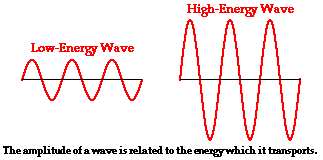Wednesday, April 2, 2014
WAVES - PROPERTIES OF A WAVE #7
Energy Transport and the Amplitude of a Wave
- Remember, a wave is an energy transport phenomenon that transports energy along a medium without transporting matter.
- A pulse or a wave is introduced into a slinky when a person holds the first coil and gives it a back-and-forth motion. This creates a disturbance within the medium; this disturbance subsequently travels from coil to coil, transporting energy as it moves.
- The energy is imparted to the medium by the person as he/she does work upon the first coil to give it kinetic energy. This energy is transferred from coil to coil until it arrives at the end of the slinky. If you were holding the opposite end of the slinky, then you would feel the energy as it reaches your end.
- In fact, a high energy pulse would likely do some rather noticeable work upon your hand upon reaching the end of the medium; the last coil of the medium would displace you hand in the same direction of motion of the coil.
- For the same reasons, a high energy ocean wave can do considerable damage to the rocks and piers along the shoreline when it crashes upon it.
How is the Energy Transported Related to the Amplitude?
The amount of energy carried by a wave is related to the amplitude of the wave.
- A high energy wave is characterized by a high amplitude;
- A low energy wave is characterized by a low amplitude.
Remember, the amplitude of a wave refers to the maximum amount of displacement of a particle on the medium from its rest position.
Amplitude is the height of the wave.
- The higher the amplitude, the higher the wave. Also,
- The higher the amplitude the higher the energy of the wave.
Can you see why?
If the wave has a high amplitude, how must the particles in the wave be moving? A lot, or a little? If you said a lot you’re right!
For a wave to have a high amplitude the particle has to be moving over a large distance (large being a relative term here, the distance may still be miniscule). The more the particle moves, the more work there is being done on the particle (work is force and distance). The more work there is, the more energy there is and so, a wave with a large amplitude has more energy then a wave with a small amplitude. If you've ever been in the ocean this may be more clear. Small little waves don’t have the energy to knock you over, but the larger ones...watch out! In sound, amplitude determines the loudness of the sound. In light, amplitude determines the brightness.

Consider two identical slinkies into which a pulse is introduced. If the same amount of energy is introduced into each slinky, then each pulse will have the same amplitude. But what if the slinkies are different? What if one is made of zinc and the other is made of copper? Will the amplitudes now be the same or different? If a pulse is introduced into two different slinkies by imparting the same amount of energy, then the amplitudes of the pulses will not necessarily be the same. In a situation such as this, the actual amplitude assumed by the pulse is dependent upon two types of factors: an inertial factor and an elastic factor. Two different materials have different mass densities. The imparting of energy to the first coil of a slinky is done by the application of a force to this coil. More massive slinkies have a greater inertia and thus tend to resist the force; this increased resistance by the greater mass tends to cause a reduction in the amplitude of the pulse. Different materials also have differing degrees of springiness or elasticity. A more elastic medium will tend to offer less resistance to the force and allow a greater amplitude pulse to travel through it; being less rigid (and therefore more elastic), the same force causes a greater amplitude.
Labels:
WAVES
Subscribe to:
Comments (Atom)

